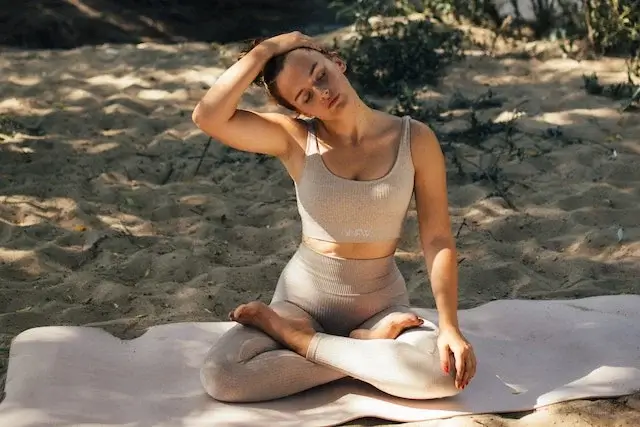If you’ve ever had a migraine before, you know that nothing can ruin a perfect day faster than a surprise attack. Nobody knows exactly why some people get migraines and others don’t; experts believe that these debilitating headaches are caused by a combination of genetic predisposition and environmental factors.
Vigorous exercise is one of those factors thought to trigger migraines in some people. However, a regular exercising and stretching routine can, ironically, also lower the frequency and intensity of migraine attacks and headaches.
Tension headaches are the most common type of headache. When you have a tension headache, you may feel mild to intense head pain and pressure around the forehead and eyes. Experts think tension headaches are caused by muscle contractions in the head and neck regions. A common triggering factor for tension headaches is bad posture and staring at the computer all day — two activities most of us are guilty of.
There is great debate on whether vigorous exercise can trigger migraines or tension headaches. Evidence suggests that intense physical activity does increase the risk for migraines in some people. However, research also shows that a regular exercising and stretching routine reduces the frequency and intensity of migraine attacks.
The importance of stretches for headache relief
Stretching is an important – yet often overlooked – form of physical activity. Most people think of stretching as something that you do before and after exercising, but a set of daily stretches can do more for your health than you think.
Taking the time to stretch every day keeps your muscles flexible and strong. This is important because flexibility is essential for performing your day to day activities with ease and without pain. Research shows that those who are less flexible are at a greater risk of losing their balance and falling.
Stretching also helps you increase your range of motion, improves blood flow to your muscles, helps you relax, and can even relieve tension headaches and migraines. In fact, research suggests that stretching exercises like yoga can be beneficial in reducing the duration, severity, and frequency of migraines as well as related psychological parameters like anxiety and depression scores.
Even though tension headaches and migraines – which can sometimes be hard to tell apart – are two different conditions, they share a major trigger: stress. We know that emotional stress doesn’t just affect the mind; when we are stressed, the body triggers an avalanche of responses designed to protect us against injury and pain. One of those responses is tensing up the muscles, which happens almost immediately after we start feeling stressed out. Chronic stress causes the muscles to stay contracted for long periods of time, which can, in turn, trigger stress-related disorders like migraine and tension headaches.
Finding relief with migraine and tension headache stretches
These 5 upper-body stretches are designed to relieve tension in the neck and shoulders, help you ease migraine pain and tension headaches, and help you relax and unwind after a long day:
Chin Tucks
Chin tucks are one of the most recommended exercises for neck pain, migraines, and headaches. The purpose is to align the head with the spine, correcting poor posture and strengthening the neck and upper back muscles. Chin tucks can be performed either standing up or in a seated position, making them perfect for repeating throughout the day.
To perform this exercise, sit or stand looking straight ahead with your back straight and your shoulders back, making sure your ears are aligned directly above your shoulders. Place two fingers on your chin and gently bend your head forwards until you feel a stretch on the base of your neck and you have a “double chin.” Hold this position for 20-30 seconds and release. Repeat three times.
Lateral Flexion Stretch
Relieve tension in the neck and shoulder by performing this simple stretch in the morning after you wake up and before going to bed at night. Lateral flexion stretches, also known as the ear to shoulder stretch, increase the angle between your shoulder and neck, and lengthen the spine.

Stand up straight and gently bend your neck to the right side as if you were trying to touch your shoulder with your right ear. Stop as soon as you begin feeling the stretch on the left side of your neck – you shouldn’t feel any pain doing this exercise. Hold for 30 seconds and change sides. Repeat 2 or 3 times on each side.
Cervical Extensor Stretch
The splenius capitis and the splenius cervicis are two pairs of deep (intrinsic) muscles on the back of the neck that are involved in movements such a shacking the head. Stretching these muscles can improve the range of motion of the neck and help elongate your spine.
To stretch the extensors on your neck, sit or stand up looking straight ahead. Gently tilt your head forward and turn your neck 20 to 30 degrees to one side until you feel a slight stretch. Don’t bend your heat too much and try not to move your shoulders – the purpose of this stretch is not to touch your shoulder with your ear. If you turned to the right, use your left hand to gently push your head forward. Hold this position for 30 seconds and change sides. Repeat 2 or 3 times throughout the day.
Shoulder Rolls
Shoulder rolls are the perfect stretch for releasing built-up stress in your neck and shoulders, and you can do it while sitting on your desk at work or when you are standing in line at the grocery store. This is one of the most effective stretches for migraine sufferers because it promotes blood flow to the brain and instantly improves your posture.
Start by properly aligning your head, neck, and shoulders. If you are sitting, keep your feet flat on the floor and avoid crossing your legs or ankles. If you are standing, keep your shoulders back, pull your stomach in and let your arms fall comfortably to the sides.
Now, gently roll your shoulders up and back in one continuous motion. Repeat 5 times and reverse it, rolling your shoulders down and up this time. Repeat a couple of times on each side.
Neck Rotations
Neck rotations are ideal for improving range of motion and relaxing your neck when it’s feeling tight. Start this exercise by sitting or standing tall and turn your neck to look at your right side, keeping your head and your body straight. Hold this position for 10 seconds keeping your chin lifted. Repeat 5 times on each side.

What else can I do to prevent tension headaches and migraines?
Even though there are countless medications, supplements, and even yoga stretches for migraines, the truth is you may never be able to prevent all headaches. Why? Because migraines are caused by myriad triggers that can’t always be prevented or even identified.
The good news is that you can reduce the frequency and severity of these headaches by managing your triggers. We recommend trying our these tips do to start learning and avoiding your triggers:
- Keep a migraine diary
- Watch what you eat and drink. If you notice certain foods give you headaches write them down. If you start noticing a pattern, stay away from that ingredient.
- Manage stress
- Consider taking a daily supplement
- Get enough quality sleep
About AKESO
AKESO formulates world class dietary supplements that provide nutritional support for the most common health issues that concern people most, such as migraines, headaches, joint health, stress & anxiety, memory, sleeplessness, ADHD, and more. Changing lives is the reasons we wake up every day passionate about the special products we provide to our customers. Helping you to get well and stay well is our bottom line.


